|
The Cane Toad is a Key Threatening Process to the Australian Nation
Declared by the Federal Government 12 April 2005.
KTB Newsletter:56
08/12/2015
This 56th Kimberley Toad Busters’ Newsletter is produced by Kimberley Specialists In Research Inc in conjunction with Kimberley Toad Busters Inc. Kimberley Specialists, a founding member of the Kimberley Toad Busters, continues to support the campaign against the cane toad by supporting www.canetoads.com.au raising funds and supporting cane toad scientific research.
Prepared by Jordy Groffen– Researcher at Kimberley Toad Busters.
Edited by Lee Scott-Virtue, President and Founder of KTB.
KTB is a tax-deductible entity.
To donate click on the following link. 
IF EVERYONE WAS A TOADBUSTER, THE TOADS WOULD BE BUSTED!
www.canetoads.com.au
kimberleytoadsbusters@canetoads.com.au
www.kimberleyspecialists.com.au
kimberleyspecialists@westnet.com.au
The Cane Toad is a Key Threatening Process to the Australian Nation
Declared by the Federal Government 12 April 2005.
United Nations Association of Australia
| Content |
|
|
| Marella Gorge Research Update 1 |
smaller reptile species |
2 |
Freshwater turtle genetics
|
|
3 |
Be aware, toads are calling
|
|
4 |
KTB book Launch!
|
|
5 |
| Reference cited |
|
6 |
Don’t forget to “Like” us on Facebook and Follow us on Twitter! 7
| Marella Gorge Research Update 1 |
KTB initiated biodiversity research on Nicholson Station in 2012 and began a 10 month research program in the unique Marella Gorge system on Nicholson station in 2013/2014. This research project was undertaken by Dutch scientist Jordy Groffen and was focussed on the short term impact of the invasive cane toad on the native biodiversity. The Marella Gorge research update for this newsletter has focussed on the smaller reptile species (also see www.canetoads.com.au for more detailed reports). The 2013/2014 KTB biodiversity research project in Marella Gorge was undertaken 5 months pre-toads arriving and 5 months after the arrival of the invasive cane toads.
Kimberley Toad Busters Scientist Jordy Groffen stated. “In this study we did not want to focus just on the larger animal species that could be impacted by the arrival of the invasive cane toads. We also wanted to see what impact was happening with smaller reptile species. To do this we put in multiple trap lines in several places along the gorge using funnel and pitfall traps.” The study was also focussed on results prior to toads arriving and results after toads began to arrive.
Early results indicate that the impact after cane toads arrived differed between species. As Jordy explains. “Three different legless lizard species were recorded in the gorge. Of the three Burton's snake neck lizard (Lialis burtonis) was the most common, followed by Delma borea and the Delma tincta. Surprisingly, the data indicated that the number of legless lizards was higher after the arrival of the cane toads in the gorge (see figure 1). While numbers of invasive feral toads were minimal the results were surprising and KTB are anxious to see if these results also show legless lizard numbers going up despite cane toad impacts on food supplies.
Other smaller reptile species like the gecko species appeared to be unaffected by the arrival of toads and population numbers remained constant. The Bynoes gecko (Heteronotia binoei) was the most commonly caught, Clawless gecko (Crenadactylus ocellatus) and the Northern spotted rock dtella (Gehyra nana) were the other two gecko species in the study area. |
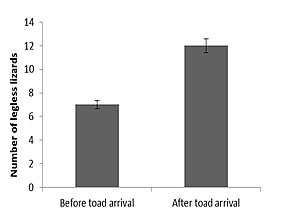 Figure 1. The number of legless lizards caught before and after the cane toad arrival Figure 1. The number of legless lizards caught before and after the cane toad arrival |
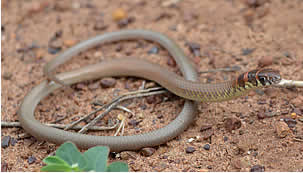 Figure 2. A Delma borea, one of the legless lizards often caught in Marella gorge Figure 2. A Delma borea, one of the legless lizards often caught in Marella gorge |
KTB continue to emphasise that smaller reptile species are as important as the bigger species. Lots of research is done on crocodiles, quolls and monitor species and are always the first to noticeably be impacted, while the decline or increase of the small reptile and insect species are rarely recorded or noticed. Small reptile species can be impacted both directly and indirectly by the cane toad. The direct impact is when they become food for the cane toad, or, like their bigger relatives, poisoned if they consume a toad metamorph. Small reptile species can also be negatively impacted indirectly, due to food competition with the toads or when one of their predator species is impacted by the cane toads. |
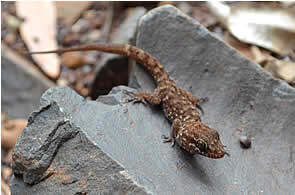 Figure 3. A Bynoes gecko on a rock in the gorge Figure 3. A Bynoes gecko on a rock in the gorge |
Depending on their position in the food chain this could be a positive or negative effect.
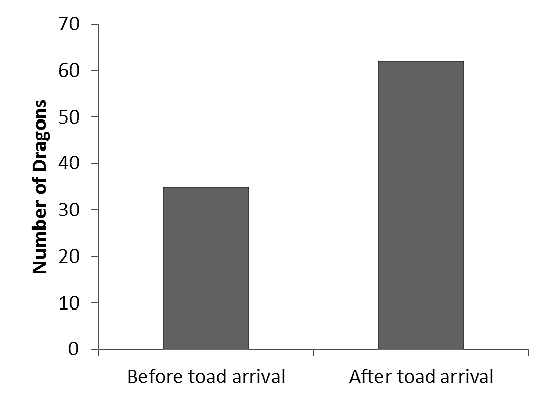
Figure 4. The number of legless lizards caught before and after the cane toad arrival |
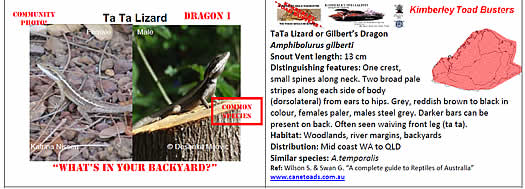
Figure 5. The “What’s in Your Backyard” identification card of the Gilbert’s dragon or TaTa lizards. If you want to have more identification card of different species in the Kimberley please go to our website, www.canetoads.com.au |
In the study of Doody et al. (2009) the Dragon species Gilbert’s dragon (Amphibolurus gilberti) increased after the arrival of the cane toad in their study area. In response to the Marella Gorge study Jordy Stated. ”We expected similar results and this was the case, the number of dragons recorded went up as soon as the toads arrived (see figure 4). This was properly due to the breeding season and because their predator species the Yellow spotted monitor was hit hard by the cane toads. “KTB will continue to record and monitor small reptile species in Marella Gorge during the October to December 2016 survey |
Freshwater turtle genetics
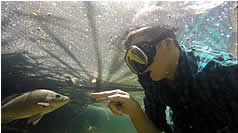 Figure 6. Jordy making friends during snorkelling for turtles Figure 6. Jordy making friends during snorkelling for turtles |
This year KTB scientist Jordy Groffen will again collect freshwater turtle samples for Dr Nancy FitzSimmons. Two freshwater turtle species, the sandstone snake necked turtle (Chelodina burrungandjii) and the northern red-faced turtle (Emydura australis) are endemic to Australia and can only be found in the northern part of Australia. Dr. Nancy FitzSimmons has been monitoring the two species in the Kimberley region for the last 15 years. In 2013/2014 KTB had already collected DNA samples for Dr. Nancy FitzSimmons of Griffith University, Queensland. This year she approached KTB to collect more samples from Long-necked turtles. There is growing evidence that this species of turtle is being pushed to the brink since the arrival of cane toads. Unlike the smaller red face the long nick is more likely to attempt to eat a toad. |
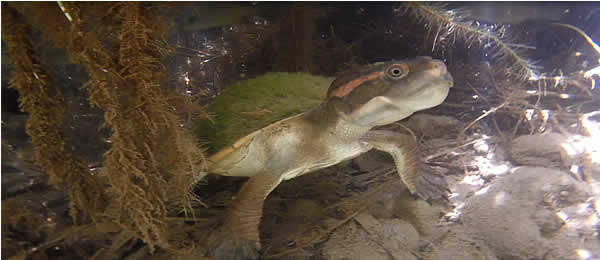
Figure 7. One of many red-faced turtles found in the lower Ord region who were not the target this year |
| Be aware, toads are calling |
| The Kimberley region has got their first rain. And as soon as the first rain fell the male cane toads were warming up there singing voice and try to luier (luier s in fishing) the females to come to their nice pound and produce 30.000 poisonous eggs! The call of the males goes “bbrrrrrrrrrrrrrr……. Bbrrrrrrrrrrrrrr…….. bbrrrrrrrrrrrrrr” repeatedly. Get these cane toads before the overtake your whole garden and neighbourhood! For any question or information please look at our website, www.canetoads.com.au. Here you can also find the call of the canetoad. |
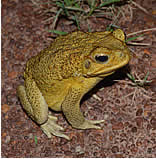 Figure 8. A male cane toad at the water’s edge Figure 8. A male cane toad at the water’s edge |
KTB book Launch!
KTB’s long awaited publication Kimberley Toad Busters. 10 Years of Fighting an Alien Invasion” has finally been printed. 2000 copies of this full color 229 page A4 publication will hit the streets on the 4th December. The official launch will take place at the Kununurra District High School Public Library on the 4th December at 7pm. Various contributors to the publication will talk about their experiences toad busting. Scientist Jordy Groffen, co-editor of the publication will introduce the book. Kimberley Authors of new pending publications in 2016 have also been invited and will be available to talk about their works. It should be a fun packed evening.
Nibbles, wine and soft drinks will be served. |
KTB is a tax-deductible entity.
To donate click on the following link. 
Reference cited
Doody J.S., Green B., Rhind D., Castellano C. M., Sims R., Robinson T. 2009. Population-level declines in Australian predators caused by an invasive species. Animal Conservation 12:46- 53.
Don’t forget to “Like” us on Facebook and Follow us on Twitter!
For further information contact
Lee Scott-Virtue: 08 91687080
If everyone became a toad buster.
The toads would be busted!
Links to some of our Educational sites and DVD’s.
1. www.canetoads.com.au
2. Kimberley toad busters Facebook pages:
https://www.facebook.com/KimberleyToadBusters
https://www.facebook.com/pages/Kimberley-Toad-Busters-KTB/113247412075404?ref=hl
3.Kimberley Toad Busters going on a toad bust:
4.View the research documentary of the Kimberley Toad Busters (KTB):
5. View Dana Lyons "Cane toad muster" song composed for the Kimberley Toad Busters:
6. View Interview with Boonya Indigenous Elder from Derby:
7. View Interview with Kevin and William Indigenous Elders from Derby:
8. View Interview with JuJu Indigenous Elder from Kununurra:
9. View KTB Chronological history from 2004 - 2013-11-02
Donate to the Kimberley Toadbusterss


Kimberley Toad Busters awards!
For more information on any of the articles contact:
Lee Scott-Virtue: KTB Founder & President 08 9168 7080 kimberleytoadbusters@canetoads.com.au
All donations are tax deductible.
Sponsors


|





